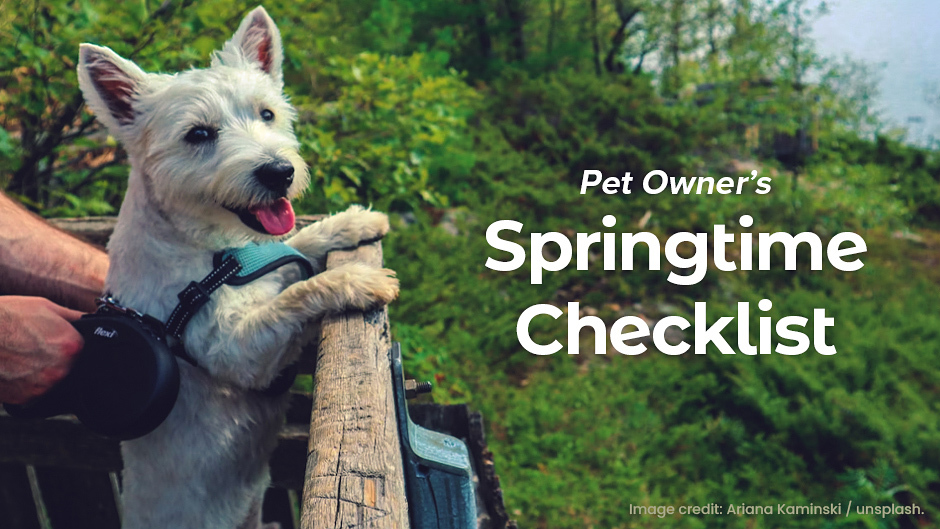Have you thrown yourself into your spring cleaning? If you’re like most people, you’re airing out the house, getting some plants in the ground, and enjoying the beauty of this season with your pet by your side. In fact, this is one of the best times of year to be a pet–the birds and squirrels are active and back to their favorite hobby of entertaining our dogs and cats, and the weather is perfect for letting some fresh air in for your cat or taking your dog on a long walk. If you’ve knocked out your spring cleaning and are ready to move on to some pet care musts, we’re here to help! We put together a list to help you plan your springtime pet care.
Use this list to identify tasks then check them off, so you have more free time to spend with your pet.
#1 Refill Your Pet’s Parasite Preventatives
Parasites like fleas, ticks, and heartworms reappear in full force this time of year. While they never completely go dormant, there is a surge of cases that come through our clinic once spring arrives.
While fleas and ticks may seem like only a nuisance, these pesky pests carry potentially fatal diseases. Heartworms can also be deadly and wreak havoc on a pet’s cardiovascular system. So, be sure to refill your pet’s parasiticides before they take full advantage of the spectacular weather with some outdoor adventures.
#2 Get a Fresh Start to the Season with Grooming
Spring is a time for renewal and fresh starts… which makes it a great time to have your pet groomed. As your dog or cat sheds their winter coat, a bath, some brushing, and nail care help them to feel their best.
Grooming your pet in spring also creates the opportunity for a quick paw and nail check to ensure they’re walk-ready. Walking on overly long nails can put a strain on a pet’s joints and cause a great deal of discomfort–and with fewer walks in winter, you may find your pet’s nails aren’t getting worn down as well as they need.
#3 Spring Clean Your Pet’s Belongings
As parasites re-emerge along with pollen, mold, and dander, it’s important to wash and clean your pet’s belongings. Not only will this renew their scent as you freshen up the rest of your house, but it will minimize your pet’s exposure to these irritants.
Be sure to wash your pet’s:
- Bed and bedding
- Collar and leash
- Food and water bowls
- Car seat covers
- Toys
- Food mats
- Food storage containers
- Rugs and carpet
#4 Check for Signs of Allergies
Everything is in bloom… and so are those spring allergies. If you’ve noticed your pet experiencing signs of allergies, be sure to make an appointment to help them find some relief from their discomfort.
The most common signs of spring allergies in pets include:
- Itchy paws
- Itchy skin
- Itchy ears and/or head shaking
- Rashes or bumps
- Watery eyes
- A runny nose
- Ear discharge
- Sneezing
- Excessive itchy and rubbing
- Greasy skin and fur
- Scabs
- Hair loss
- Odor
#5 Survey Your Home & Yard for Spring Hazards
Finally, you want to safeguard your pet from any spring hazards that could do them harm. This includes possible toxins and tools that may present a physical danger. A little preparation, organization, and due diligence in this area could save your pet’s life.
Be sure to:
- Put away any gardening equipment after use
- Store herbicides and pesticides out of reach
- Place all household cleaners in a pet-safe location
- Close windows and doors before you leave
- Survey your home and yard for toxic plants
- Check your fence line for any weak spots and repair them
Start Spring on the Right Paw
Take advantage of the sunshine and warm weather while checking these items off your to-do list. We’re here for you if you need to refill your pet’s prescription and to help you better understand your pet’s needs. We hope that your spring is filled with bright memories with your pet. Happy spring from your veterinary team!

